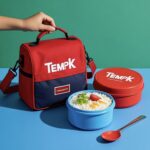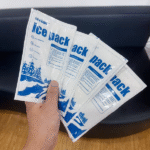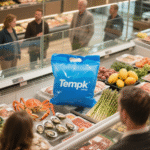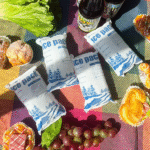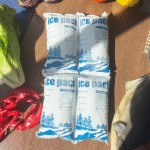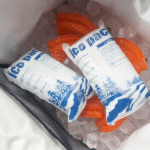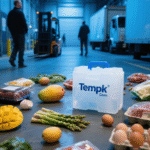Apa Sebenarnya Paket Es Kering vs Es Kering?
Intro: Paket es kering tidak selalu sama dengan es kering. Dalam pekerjaan pengiriman dan rantai dingin, paket es kering dapat berarti lembaran PCM berbasis polimer yang Anda hidrasi dan bekukan, atau kantong yang sebenarnya berisi CO₂ padat. Mengetahui yang mana yang Anda miliki membantu Anda mencapai suhu yang tepat, menghindari bahaya, dan tetap patuh 2025. Artikel ini menggabungkan dan menyempurnakan tiga draf yang Anda berikan.
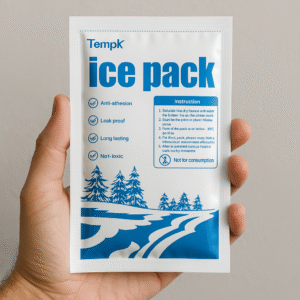
-
Apa a Paket es kering adalah dan mengapa istilah ini menyebabkan kebingungan (TAIL PANJANG: paket es kering vs es kering)
-
Kapan memilih a Paket es kering atau benar es kering untuk jalurmu
-
Cara mengemas, label, dan menangani setiap zat pendingin dengan aman dan efisien
-
2025 tren: PCM suhu −21°C yang dapat digunakan kembali, paket hybrid, dan bahan yang lebih ramah lingkungan
Apa itu dry ice pack dan mengapa istilah tersebut membingungkan pembeli?
Jawaban singkat: Paket es kering tidak selalu berupa CO₂ padat; sering kali merupakan paket perubahan fase yang dapat digunakan kembali dan dirancang untuk pendinginan set-point mendekati 0°C atau −21°C. Beberapa vendor juga menggunakan “keran es kering” untuk menggambarkan es kering kemasan. Itu sebabnya Anda akan melihat frasa yang sama pada dua produk yang sangat berbeda.
Perincian bahasa Inggris biasa: Jika paket Anda diisi ulang di dalam freezer dan dapat digunakan kembali, Anda memegang lembaran atau pelat PCM—tidak ada CO₂ di dalamnya. Jika paket Anda mengeluarkan gas dan memerlukan sarung tangan dan label, itu benar es kering (co₂ solid). Perbedaan ini penting ketika Anda perlu kedinginan (2–8 ° C.), beku (≈−20°C), atau sangat dingin (≈−78°C) pertunjukan.
Bagaimana cara kerja paket es kering (lembar PCM) dibandingkan dengan es kering?
PCM “paket es kering”: Lembaran fleksibel dengan sel polimer penyerap super yang Anda rendam, membekukan, dan menggunakan kembali. Itu membeku seperti air, mempertahankan titik setel yang stabil (seringkali sekitar −21°C atau 0°C), dan tidak mengeluarkan gas.
Es kering (co₂ solid): Karbon dioksida membeku pada suhu sekitar −78,5°C. Ia melewati fase cair dan langsung berubah menjadi gas (sublimasi), jadi paket harus melampiaskannya. Suhu ini menghasilkan suhu dingin yang sangat dalam dalam jangka waktu lama, namun menimbulkan risiko radang dingin dan paparan CO₂.
| Atribut | Paket es kering (PCM) | Es kering (Co₂ solid) | Apa artinya bagimu |
|---|---|---|---|
| Bahan inti | Polimer terhidrasi/PCM | CO₂ beku | Pilih berdasarkan apakah Anda memerlukan pendinginan set-point yang dapat digunakan kembali atau daya ultra-dingin |
| Suhu kerja | ~0°C atau ~−21°C | ~ −78.5 ° C. | Melindungi barang dingin/beku vs. simpan barang-barang yang kokoh dalam keadaan beku |
| Perubahan Fase | Membeku/meleleh | Sublimasi (Solid → Gas) | Tanpa bahan bakar vs. Gas CO₂ memerlukan ventilasi |
| Status Hazmat | Umumnya non-hazmat | Dan 1845, Kelas 9 | Pengiriman yang disederhanakan vs. pelabelan, pelatihan, ventilasi |
| Penggunaan kembali | Ratusan siklus yang dapat digunakan kembali | Dikonsumsi dalam perjalanan | Mengurangi limbah dan OPEX vs. penggunaan satu kali |
| Penggunaan khas | Menghasilkan, 2–8°C farmasi, Makanan beku D2C | Es krim, makanan laut beku, biologi ultra-dingin | Sesuaikan jalur Anda dan toleransi produk |
Tips praktis yang bisa Anda terapkan hari ini
-
Jika label mencantumkan titik setel (MISALNYA., −21 ° C.), itu paket es kering (PCM), bukan co₂.
-
Jika disebutkan UN1845 atau “kemasan ventilasi,” Anda sedang berurusan dengan es kering.
-
Produk yang sudah didinginkan sebelumnya, pendingin, dan pengirim. Hal ini mengurangi beban dan memperpanjang waktu tunggu.
-
Untuk makanan beku, bungkus muatan dengan a Paket es kering di semua sisi untuk kontak seragam.
-
Untuk es kering, selalu biarkan gas keluar; jangan pernah mengecilkan atau menyegelnya dalam wadah kedap udara.
Contoh dunia nyata: Sebuah merek peralatan makan mengganti dua bata gel dengan dua suhu −21°C Paket es kering lembaran dan peningkatan pengisian kekosongan. Keluhan kedatangan cuaca hangat menurun pada puncak musim panas sementara kerusakan akibat cuaca beku tetap datar.
Kapan sebaiknya Anda memilih paket es kering vs es kering sejati?
Aturan praktis: Gunakan kantong es kering untuk jalur berpendingin dan jalur beku standar; gunakan es kering untuk jalur yang sangat dingin atau saat Anda membutuhkan atmosfer CO₂. Ini menyeimbangkan kualitas produk, beban kepatuhan, dan biaya.
Mengapa itu berhasil: A Paket es kering menghantarkan suhu dingin terkendali di dekat titik setelnya, mencegah pembekuan berlebihan pada produk dan bahan biologis. Es kering memberikan suhu dingin yang ekstrim dan penyangga yang panjang namun memicu aturan hazmat dan memerlukan ventilasi dan APD.
Kerangka keputusan cepat (centang semua yang sesuai)
-
Suhu produk terendah yang diperbolehkan adalah ≥ −30°C → pilih a Paket es kering (−21 ° C.).
-
Anda memerlukan suhu ≤ −40°C selama berhari-hari → pilih es kering.
-
Anda ingin dapat digunakan kembali, pendinginan non-hazmat → pilih a Paket es kering.
-
Anda mendapat manfaat dari atmosfer CO₂ di dalam kotak → pilih es kering.
-
Anda mengirim melalui udara dengan batas hazmat → pilih a Paket es kering.
| Skenario | Rentang target | Pilihan terbaik | Mengapa | Watch -outs |
|---|---|---|---|---|
| Menghasilkan & 2–8°C farmasi | +2 °C hingga +8°C | Paket es kering (0 °C atau +5 °C) | Lembut, pendinginan yang stabil | Paket dan pengirim pra-kondisi |
| Makanan penutup beku D2C (24–48H) | −25°C hingga −10°C | Paket es kering (−21 ° C.) | Dapat digunakan kembali dan non-hazmat | 360° bungkus untuk menghindari hotspot |
| Bahan biologis/makanan laut beku | ≤ −40°C | Es kering | Buffer ultra-dingin | Ventilasi, APD, Pelabelan UN1845 |
| Jalur panjang dengan penundaan | −30°C hingga −10°C | Hibrida: Paket es kering + es kering kecil | Memperpanjang ketahanan tanpa pembekuan berlebih | Berat ekstra; aturan hazmat berlaku |
Pentingnya pengepakan dan kepatuhan (salin dan gunakan)
2025 tren paket es kering dan rantai dingin yang penting
Apa yang baru 2025: Dapat digunakan kembali Paket es kering sistem (terutama pelat bersuhu −21°C) sedang mengganti gel satu arah di jalur makanan beku. Paket hibrida (PCM + sedikit muatan es kering) membantu menutupi penundaan tanpa membekukan item sensitif secara berlebihan. Penelitian tentang “es jeli” yang dapat terbiodegradasi dan isolasi yang lebih baik (Panel VIP) mengurangi limbah sekaligus meningkatkan waktu tunggu.
Perkembangan terbaru sekilas
-
Desain PCM yang dapat digunakan kembali: Hidup lebih lama, lembaran yang dipotong sesuai ukuran memudahkan pengembalian dan pengembalian logistik.
-
Validasi berdasarkan data: Lebih banyak ukuran tim Paket es kering dimuat dengan pencatat data rute, tidak menebak.
-
Strategi hibrida: Lapisan tipis es kering di atas PCM menambah penyangga keamanan untuk cegukan pembawa.
-
Bahan yang lebih ramah lingkungan: Munculnya hidrogel dan film yang dapat didaur ulang mengurangi dampak akhir masa pakainya.
Wawasan pasar: Frozen D2C terus berkembang, sementara farmasi memperketat kepatuhan. Harapkan penegakan hukum yang lebih ketat terhadap deklarasi es kering dan penerapan PCM non-hazmat yang lebih luas untuk jalur rutin yang dibekukan dan didinginkan.
FAQ paket es kering (dan dasar-dasar es kering)
Apakah paket es kering sama dengan es kering?
TIDAK. A Paket es kering biasanya merupakan paket PCM yang dapat digunakan kembali dengan suhu sekitar 0°C atau −21°C; es kering adalah CO₂ padat pada ≈ −78,5°C.
Berapa lama kantong es kering tetap dingin?
Rencanakan 24–36 jam per kotak dengan insulasi yang baik dan kontak 360° penuh; tambahkan lembaran atau insulasi yang lebih baik untuk jalur yang lebih panjang.
Bisakah saya terbang dengan kantong es kering?
Umumnya ya—ini bukan UN1845. Jika Anda menambahkan es kering, ikuti batasan maskapai dan curahkan paketnya.
Kapan saya harus menghindari es kering?
Hindari dengan barang-barang yang sensitif terhadap pembekuan dan di ruangan yang berventilasi buruk. Gunakan a Paket es kering untuk suhu dingin terkendali atau beku standar.
Apa cara paling aman untuk menangani es kering?
Kenakan sarung tangan dan pelindung mata, dan memastikan ventilasi. Jangan pernah menyegel es kering dalam wadah kedap udara yang kaku.
Ringkasan dan Langkah Selanjutnya
Kunci takeaways: Pilih A Paket es kering untuk stabil, pendinginan yang dapat digunakan kembali di jalur dingin dan beku standar; memilih es kering untuk pengiriman beku yang sangat dingin atau beberapa hari. Ukur zat pendingin berdasarkan jalur dan isolasi Anda—bukan dugaan. Paket hybrid dapat menjembatani kesenjangan ketika terjadi penundaan.
Rencana aksi: Petakan setiap SKU ke rentang suhu yang diperbolehkan, pilih zat pendingin dengan bahaya paling ringan yang memenuhinya, validasi dengan pencatat data di musim panas dan musim dingin, dan standarisasi SOP berdasarkan panjang jalur. Panggilan untuk bertindak: Dapatkan rencana paket yang disesuaikan dan perkiraan waktu tunggu untuk jalur Anda—hubungi Tempk hari ini.
Tentang tempk
Tempk merancang kemasan rantai dingin yang dapat Anda terapkan dengan cepat dan dalam skala besar. Portofolio kami mencakup dapat digunakan kembali Paket es kering piring (−21 ° C., +5 ° C., +18/22 ° C.), pengirim yang tervalidasi, dan SOP paket hybrid. Kami membangun standar food grade dan fokus pada rendah limbah, kinerja keandalan tinggi.
















